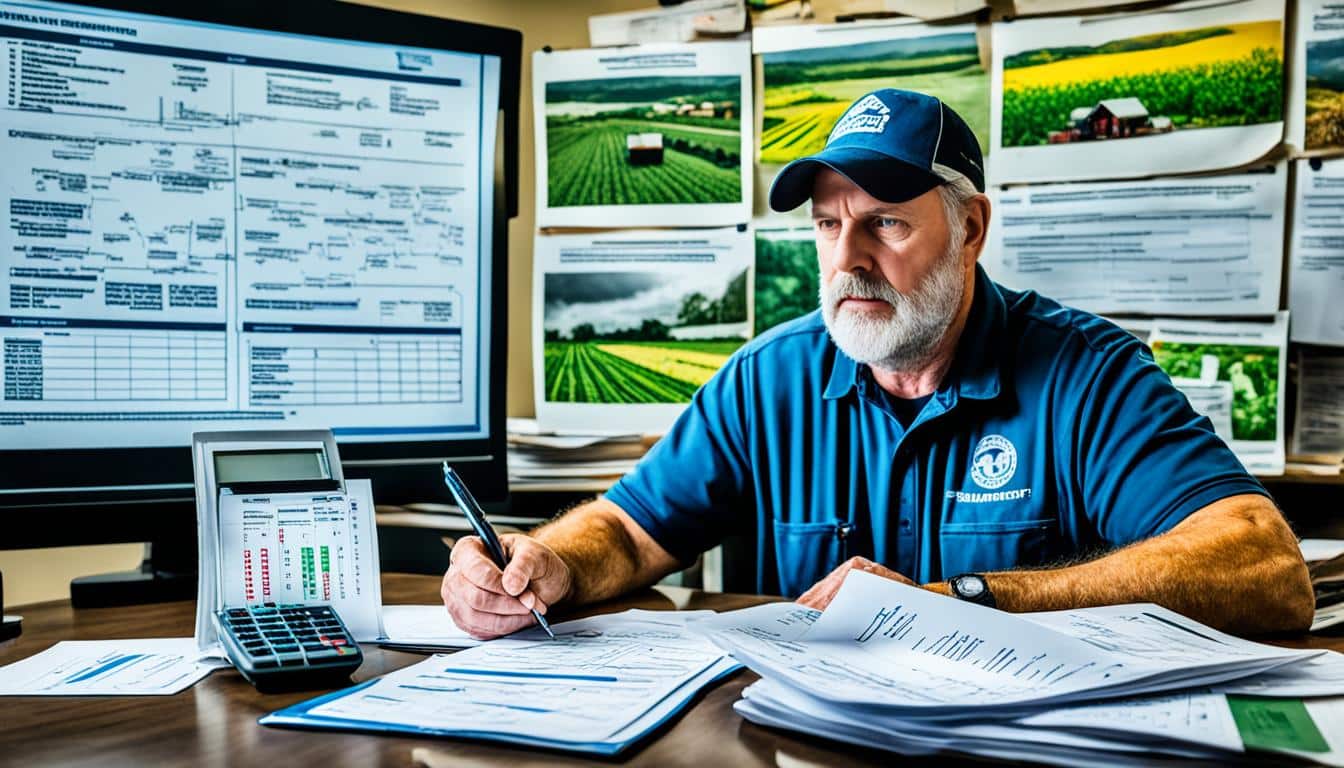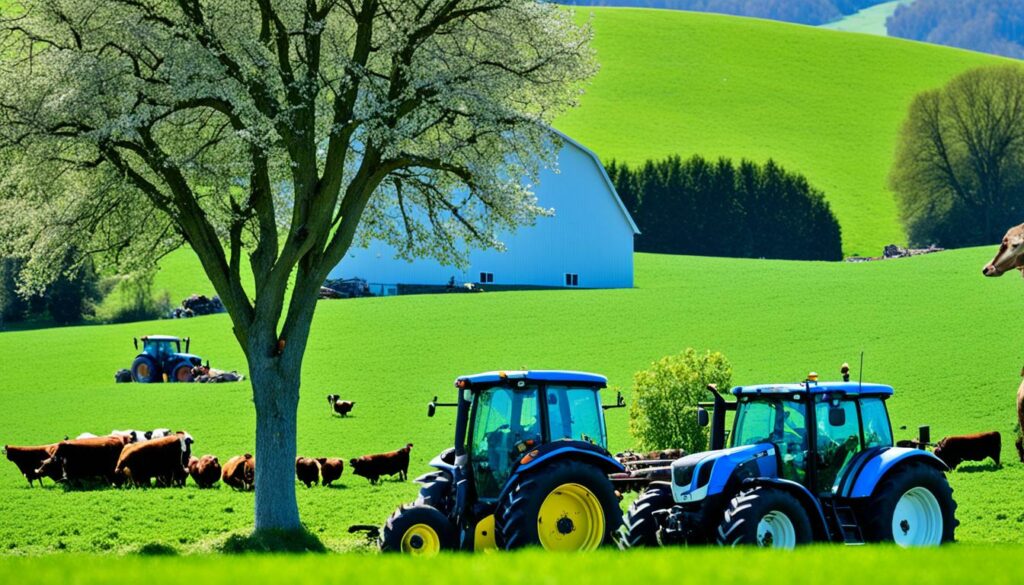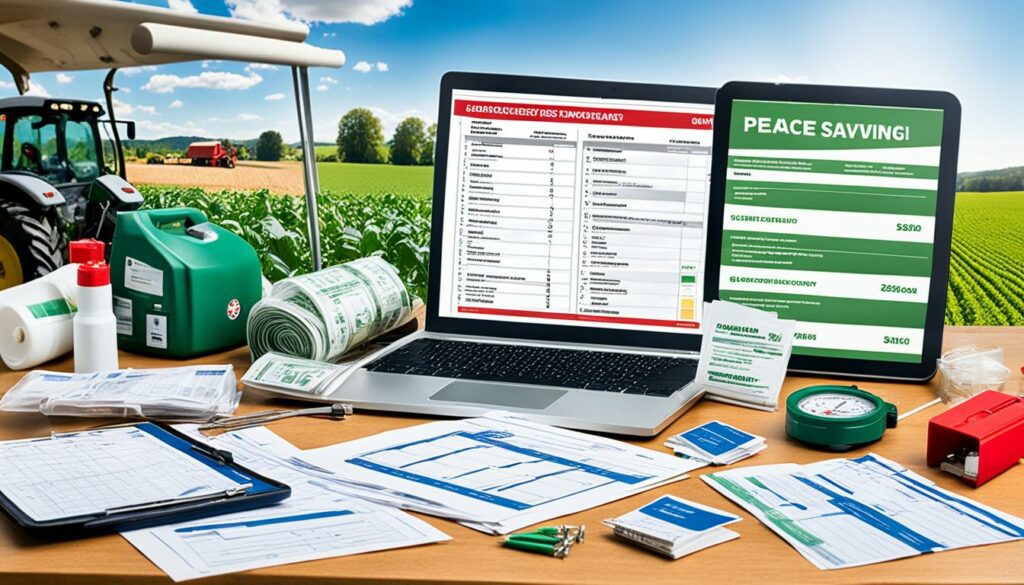Menu

Unpredictable emergencies like severe weather or equipment accidents can hit any farm. Sadly, many farmers don’t have a strong plan in place. But, creating a detailed emergency plan can save lives and lessen financial blows from these events.
It’s crucial to plan financially for farm emergencies. This plan should fit the farm’s size and operations, involving both family and employees. key parts include roles, evacuation paths, disaster steps, and emergency contacts. Such planning is seen as life-saving and smart for disaster impact reduction on the farm.
When we talk about getting ready for emergencies on the farm, a carefully thought-out plan is key. This is very true in places like Minnesota. There, farm life means dealing with tornadoes, floods, heavy snow, and fires. So, a strong emergency plan isn’t just good to have; it’s a must. This plan should cover what to do if you need to stay put or if you have to leave.
Planning for emergencies on the farm is more than just quick reactions. It’s all about preparing well and making sure everyone is ready. In your plan, make a list of important phone numbers. These include the vet, local emergency services, the Extension office, and your insurance agent. It’s smart to go over your insurance to make sure it’s right for an emergency.
It’s also a good idea to draw detailed maps of your farm. Mark where everything important is, like all buildings, ways in and out, where the animals are, and if there are any dangerous materials. These maps are really valuable in emergencies. They help you move quickly and wisely on your own land. Keeping a detailed list of what you have, like the animals, crops, and machines, is also vital. This helps you check the damage and figure out how to get things back to normal after a crisis.
Getting ready for farm emergencies also means staying in touch with key people. This includes those who supply things like milk, food for the animals, and fuel for your machines. Make sure you have their numbers ready to keep things running as smoothly as possible after a disaster.
And don’t forget about getting ready for health emergencies too, like heart attacks or gas dangers. Checking gas levels near areas with manure is a life-saving step. It helps prevent bad gas accidents.
In the end, a good emergency plan not only keeps people safe but also protects the farm’s finances. This way of thinking about emergencies on the farm is the foundation of being strong in the face of adversity.
It’s key to know about common farm emergencies for good emergency planning. The article states that emergencies can hit farms anytime, from both natural and human causes. You must know how to deal with things like natural disasters and accidents on a farm.
Natural emergencies include things like tornados, floods, and earthquakes. Each of these needs its own plan to handle. Remember, the type of disaster and how often they happen can change by location.
Man-made emergencies are caused by people, like fires and chemical spills. There are many kinds, such as accidents with animals and machines. It’s important to understand and plan for these risks.

Your emergency plan must cover getting people and animals to safety. It should also keep dangerous materials away from livestock. Dealing with the many risks on a farm needs a full plan. This plan helps save money and prevents big problems.
| Type of Emergency | Natural | Man-Made |
|---|---|---|
| Examples | Tornadoes, hurricanes, wildfires, floods, severe winter storms, severe dust storms, lightning strikes, earthquakes | Chemical spills, explosions/fires, animal handling incidents, grain entrapments, power failures, equipment incidents, workplace violence |
| Planning Considerations | Evacuation procedures, sheltering plans, communication systems | Hazardous materials management, emergency contact information accessibility, specialised training |
An effective plan looks at both natural and human dangers on a farm. By being well-prepared and knowing what to do, we keep our farm safe.
It’s crucial to have a strong plan for emergencies on the farm. This plan should cover all kinds of disasters. By doing this, you protect the farm and everyone on it.
A detailed farm map is very important. It should show all buildings and roads. It also should show where animals and dangerous materials are, and where to turn off utilities.
In the plan, list all your animals, crops, and machinery. This helps you keep track of everything that’s important for making the farm run well again after a disaster.
It’s key to have clear escape plans for your farm, especially in places with many dangers like Minnesota. Prepare multiple ways to leave, so people and animals can get out quickly and safely.
Regularly checking and practising these plans makes sure you’re ready for any emergency.
Choose safe spots for people and animals during emergencies. Look for places not likely to be harmed, like high up areas for floods, or fireproof buildings.
Also, pick and tell everyone about meeting spots for after everyone’s evacuated. This helps with counting and finding important help fast, like vets or insurance.
| Essential Components | Description |
|---|---|
| Farm Map | Includes buildings, access routes, livestock locations, hazardous substances, and utility shut-offs |
| Inventory Lists | Details of livestock species, crop types, machinery, and hazardous materials |
| Emergency Contacts | Veterinarian, local emergency services, county management, insurance agent |
| Escape Procedures | Pre-defined exit paths for personnel and livestock |
| Safe Locations | Identified shelters least likely to be impacted during a disaster |
Keep to these steps and refresh your insurance and emergency supplies often. Ensuring you’ve enough tools and fire extinguishers is crucial. Having money set aside for emergencies and clear ways to talk are vital too.
Starting a farm emergency fund is key to keeping your farming business safe. To begin, work out how much money you might need for likely emergencies. Look at what has happened before and think about what your farm might need every season. This way, you can make sure your responses will be on point when needed.

First off, review what has cost your farm in the past. Tally up expenses from emergencies like bad weather or broken equipment. This will help you set a real starting amount for your fund. Also, think about how farm spending changes with the seasons. Covering all potential costs is the goal here.
The main point of having a farm emergency fund is to soften the blow of sudden disasters. Experts say this fund should handle 3 to 6 months of all costs. With this safety net, your farm can keep running even if things go badly.
Having a clear plan makes this safety net stronger. You should have steps ready for when emergencies happen. This includes how to get everyone to safety, where to meet, who to call, and maps showing escape routes. Detailed plans protect people and animals. They also show the value of being ready to act.
Don’t forget about family, workers, and local help when making emergency plans. Including everyone helps the whole team react better. This teamwork cuts down on risks more effectively.
To keep your farm safe, you need to save and manage your money well. Setting money aside for emergencies is smart. It makes your farm stronger and more stable in the long run.
Dealing with financial risks in farming needs a wide thinking. It’s more than the everyday costs. To handle the uncertainties, it’s smart to have many ways to earn money. And, having good insurance is also key.
Adding different ways to make money on the farm is a smart move. This way, if one source drops, you have others to rely on. For instance, you can:
Getting the right farm insurance coverage is vital. It shields farmers from big losses. Whether it’s bad weather or diseases, insurance can help. Key areas to cover are:
By using all these steps in a solid plan, your farm can keep going, even in tough times. This gives you a solid base for continued success.
| Region | Top Insured Crops | Major Insurance Program | Total Liability (Million $) |
|---|---|---|---|
| Kansas | Wheat, Corn, Soybeans | Dairy Revenue Protection | 236.6 |
| Oklahoma | Wheat, Soybeans, Cotton | Feeder Cattle | 144.9 |
| Texas | Cotton, Wheat, Corn | Citrus Trees | 176 |
Efficiently handling a farm emergency fund is crucial for financial security in agriculture. Have an emergency fund ready with 3 to 6 months’ worth of living and farming costs. Yet, it can be hard to know what to save, especially since monthly bills can change a lot for those living in the countryside. So, it’s vital to check and change how much you save based on your farm size and the risks you face.
Start by clearly stating what the fund is for. Knowing the purpose makes sure it meets your needs when emergencies strike. Also, keep it easy to get to. This allows you to use the money quickly when needed. But, also think about how to earn some interest on the fund balance to make the most of your money.

For saving money on the farm, it’s smart to have different ways to make and save money along with the right insurance. Property insurance keeps your buildings and equipment safe from fire and other damage. Life insurance helps your loved ones if something really bad happens to you. Using enterprise budgets, which you can get from local farm groups, helps you work out what it costs to make things. This guides you to wisely use money and reduce risks.
Keep adding to your emergency fund on a regular basis. Make sure you review it and update it as your farm or needs change. This keeps your fund strong and ready for any surprises. A study found that over half of small farms don’t have a plan for emergencies. But those that do had less trouble when something went wrong.
Now, here are different types of insurance that can help keep your farm’s money safe:
| Insurance Type | Coverage |
|---|---|
| Life Insurance | Helps beneficiaries with farm expenses upon the operator’s death. |
| Disability Insurance | Offers payments when the farmer is sick or hurt and can’t work. |
| General Liability Insurance | Protects against bodily injury, property damage, and more. |
| Property Insurance | Keeps buildings and equipment safe from certain damage (not floods). |
| Workers’ Compensation Insurance | Helpful for farms with people working or volunteering. |
| Federal Crop Insurance | Gives market farmers a way to protect against crop risks, like a plan for the whole farm’s income. |
To wrap up, keeping a disciplined hy capability when time and funds are tight. By setting clear objectives, regularly reviewing, and using the right insurance, you build a strong financial ground. This helps you face any surprise costs with confidence.
Farmers can get help from the government when hit by natural disasters. One key form of aid is the USDA disaster support.
FSA emergency loans are offered by the USDA to help farmers. To qualify, farmers need to show a significant drop in crop production. These loans help cover many costs like fixing property, paying for production, daily living, and changing how the farm operates.
Getting federal assistance for farm crises follows a set process. Farmers must prove their losses come from the disaster. They also need a bank’s refusal to lend them money. Loans can go up to $500,000, depending on the losses.
The USDA shapes repayment plans for each farmer. Plans consider the life of the assets bought, the farmer’s ability to repay, and the loss’s nature. Operating expense loans must be paid back in 12 months, or up to 18 months to match production times. The interest rates are fair and change monthly, reflecting the market conditions.
| Loan Type | Interest Rate |
|---|---|
| Farm Operating – Direct | 5.250% |
| Farm Ownership – Direct, Joint Financing | 3.500% |
| Maximum interest rates for Guaranteed Loans | SOFR + 6.75% |
These rates help farmers repay the loans and restart. They show the government’s support during tough times, making farming more robust for all.

As a farmer, I see how vital risk management for farming is. It heavily depends on having the right insurance. Insurances for farms do more than protect money. They’re key parts of a good emergency plan.
Tornadoes, floods, wildfires, and man-made dangers threaten farms every day. If we’re not prepared with insurance, the costs could be huge. This might even stop the farm from running.
Insurance acts as a shield, saving farm things like buildings, gear, and animals. It makes sure money comes in after any disaster. This helps the farm get back up quickly.
To use insurance well in risk management for farming, knowing the farm’s needs is a must. You make policies fit the farm, handling any common or rare dangers. Always update these policies to stay ready for new risks.
Training farm hands with emergency simulations gets everyone ready for the worst. Add in an emergency list and a solid disaster plan, and your farm is safer. This is a key part of the overall farm safety strategy.
Planning how to move animals if trouble hits is essential. Know where to go with them, have enough food and water, and connect with vets in advance. Working with local emergency teams adds even more protection. This makes sure your farm bounces back fast from disasters.
In short, farm insurance is a must for keeping your farm safe. It not only protects your things but also backs a full emergency plan. Checking that your insurance fits your farm well is smart. It helps in dealing with all the risks of farming.
It’s crucial to have a detailed contingency plan for farms. Begin by assigning emergency roles and responsibilities to your team. This helps in any crisis, like a tornado or flood, by making sure everyone knows what to do.
In creating a strong contingency plan, defining specific roles is essential. For farmers in places like Minnesota, these roles could involve checking gas levels near manure. It might also mean ensuring workers use the right safety equipment and know First Aid. This is key as farming is risky.
| Responsibility | Role | Emergency |
|---|---|---|
| Gas Level Monitoring | Manure Storage Manager | Toxic Gas |
| Grain Bin Safety | Equipment Handler | Entrapment |
| First Aid Training | Team Trainer | Injuries |
Good communication is vital during emergencies. So, having a strong farm communication plan is a must. It ensures quick, effective sharing of important info, making responses better coordinated.
Preparation involves creating a detailed emergency contact list. Include numbers for the vet, emergency services, and your insurance company. During evacuations or staying put, clear lines of communication are vital. This lets everyone know what to do, like moving animals or dealing with insurance.
A proper contingency plan gets the farm ready for short and long-term challenges. By focusing on farm communication and clearly assigning emergency roles, farmers protect their livelihood. They also help in quickly getting back to normal after a crisis.
When preparing for farm emergencies, it’s key to understand the various crises that can strike. These can range from bad weather to accidents with equipment. Being ready for these emergencies starts with a well-thought-out plan. This plan is essential for farms to deal with disasters well and protect lives.

Developing a detailed emergency action plan is crucial. It includes several important steps. Each of these steps is designed to help in different emergency situations. This plan should say who is in charge during a crisis, show ways to get out safely, and explain how to deal with different emergencies. It should also list all the important phone numbers you might need. This plan must cover how to leave quickly and what to do if you must stay where you are to stay safe.
To manage financial risks well, farmers need a special savings plan for emergencies. This savings plan should:
Having a complete map of your farm can really help when emergencies happen. This map should show the main buildings, the best ways to get out, and where your animals are. It should also point out any danger spots and where to turn the water and gas off. This kind of map makes it easier to leave fast and know where to go to stay safe.
Telling everyone on your farm about your emergency plans is very important. Everyone should know what to do in a crisis. Making sure everyone is involved and understands these plans well is key. Also, these plans should be easy for everyone to get to and read.
It’s also important to keep up with what help and loans you might get if there’s a crisis. Don’t forget to check your insurance from time to time to make sure it still fits your needs.
| Emergency Action Plan | Contents |
|---|---|
| Identification of Key People | Roles and responsibilities during emergencies |
| Exit Routes | Clear paths for evacuation |
| Handling Procedures | Steps for managing specific crises |
| Emergency Contacts | List with vet, local emergency management, insurance agents, etc. |
Being ready for emergencies on the farm is key. So, having a detailed list of who to call is a must. This list makes sure you have the numbers you need. It’s for everyday help and for when things go really wrong.
Farmers in Minnesota know they must be ready for anything. This means having important contacts saved:
It’s smart to be ready for different types of emergencies. Knowing what to do if you can’t leave, or if you need to get out fast, is important. This includes planning out how you’ll handle your animals in such situations.
Keeping an eye on your animals’ health is also crucial. Knowing what to look for and acting fast can be life-saving. Learning some basic First Aid is helpful. This means you can help your animals right away, if needed.
Remember to always watch out for deadly gases and avoid risky areas. In accidents like getting caught in a grain bin, having the right tools is a must.Call 911 if things go wrong. But don’t rush to help without the proper gear.
It’s not just about having the contacts. It’s how you use them that matters. Making sure your list is easy to use in a crisis is essential.
For more tips on making an emergency plan, check out the University of Minnesota Extension’s guide.
Unexpected disasters can hit hard and fast. For farmers, getting emergency financial help is crucial. It keeps their farms running smoothly. Knowing about the agricultural emergency loans and who can get them helps a lot. It makes it easier for farmers to get back to their work quickly.

To get these loans, farmers need to meet certain rules. One big rule is they need to have lost 30% of their main crop in a disaster area. They must also show they plan to keep farming. If farmers can’t get a loan from a bank, they might still qualify, especially for larger loans.
There are different loans to help with various farming needs:
The interest rates on these loans change every month. But you’ll always get the rate that was lowest when you applied or when you got the loan. This way, paying back the loan is a bit easier when times are tough.
| Loan Amount | Declination Letters Needed | Repayment Terms |
|---|---|---|
| Below $100,000 | Case by Case | 12-18 Months |
| $100,000 – $300,000 | One Letter | 12-18 Months |
| Above $300,000 | Two Letters | 12-18 Months |
Your go-to guide for understanding farm emergency support and applying for it.
Getting the right disaster recovery loans is key to keeping a farm running. It ensures financial health despite any surprises.
In the realm of on-farm emergency planning, a strong shelter-in-place strategy is crucial. Farms without a clear emergency action plan face higher risks of big losses in emergencies. Such plans are key to emergency protocols for agriculture. They help manage disasters, keeping everyone and the animals safe.
An effective plan needs detailed farm maps. These maps should show buildings, roads, and important utility points. They help in managing emergencies and guide rescuers. You must plan how to escape, where to put the animals, and where to meet up. It is vital that everyone on the farm understands these plans, including family and workers.
Shelter-in-place strategies are for times when leaving is not an option. For example, in severe storms when outside help may be slow. Having backup power and plans for if roads are blocked is crucial. Keep a kit ready with items like bandages, eye wash, and medical tape. This makes the farm more self-sufficient.
Connecting with local emergency services is also important. Talk to the sheriff, fire brigade, and ambulance, and make specific plans for threats in your area, like tornadoes or floods. Keep checking and updating these plans. Farm needs and risks change, so the plans must also change.
Looking after a farm’s financial health is key in keeping it going and making a profit. It’s important to regularly check on the money situation. This includes looking at financial statements often to see where money is coming and going. By doing this, it’s easier to figure out how to spend less and earn more.
When it comes to managing a farm’s money, you need to check what’s spent against what’s earned. This way, farmers can see if they are working efficiently and making money. Using technology to handle finances can be a big help. It lets farmers spend more time on important decisions and less time doing paperwork. Plus, it can help keep track of money better and tweak plans when needed.

It’s also good to not just look at the present but to think ahead. Regularly checking cash flow can show trends and help predict the future. This helps in making changes early to stay ahead. It’s wise to have more than one way to make money. This spreads out the risk if something affects the market or the weather.
It’s a juggle to meet immediate needs while keeping an eye on the future. Setting aside money for important buys and emergencies is crucial. It shows a farm is thinking about both short and long-term financial health.
Following these steps in managing money can make a farm stronger financially. This paves the way for a farm to not just survive but to do well over time.
It’s vital to prepare your farm staff for emergencies to keep your farm safe. You should give them thorough emergency response training and the right tools. This way, your farm’s readiness for emergencies will greatly improve, cutting risks during crises.
It’s key that everyone on your farm knows what to do when an emergency hits. They need training and practice for events like fires, chemical spills, and bad weather. By doing regular drills, your staff will know how to act fast and well in real emergencies.
The Comprehensive Preparedness Guide 101 recommends involving everyone in the drills, even if they need special help. Learning from past bad events helps make emergency responses better. This way, your whole team will be ready to face any emergency.
A safety kit is crucial for being ready on the farm. It should have first aid items, fire extinguishers, protective clothes, lights, and batteries. A well-prepared kit means you can quickly take care of safety and medical needs in an emergency.
Bodies like the UK’s HSE and Safe Work Australia stress the importance of these kits. By following their advice, your farm’s kit will be even more useful in tough times.
The following table provides a checklist to ensure your farm staff is well-equipped and trained:
| Training Element | Details |
|---|---|
| Emergency Drills | Regular drills for fire, chemical spills, severe weather, etc. |
| Response Training | Specific roles and responsibilities, handling emergency equipment. |
| Farm Safety Kit | First aid, fire extinguishers, protective gear, flashlights, batteries. |
| Community Engagement | Involving all staff, individuals with access needs, including pets and livestock management. |
Keeping up with emergency alerts for farms is very important. It’s crucial for farm owners and workers to know about potential disasters. A good alert system helps everyone stay safe in farming emergencies.
Emergency escape procedures and routes, along with meeting points, are needed. So is a method to check that everyone is accounted for. A detailed map showing important locations and updates is a must.
Having a list of emergency contacts is vital too. This includes local services, vets, insurance agents, and those who provide essential farm needs. Keeping this list updated can help a lot during an emergency.
Farm plans should cover both natural and man-made threats. This includes severe weather and accidents. By knowing the dangers, farms can make plans that help everyone stay safe.
To prevent fire risks, keep explosive materials away from animals. Have clear evacuation plans that consider possible blockages. A well-packed farm safety kit supports quick first aid and emergency care.
Working with local emergency teams is also key. This partnership reduces harm and ensures quick help. Regular disaster drills with them make sure everyone knows how to respond well in emergencies.
| Essential Preparedness Elements | Details |
|---|---|
| Emergency Escape Procedures | Routes and systems for accounting for people |
| Farm Map | Includes buildings, access routes, livestock locations, hazardous substances |
| Emergency Contact List | Local emergency services, vets, insurance agents, service providers |
| Safety Kit | Bandages, sterile eye wash, antibiotic ointment, instant cold packs |
| Disaster Drills | Regular drills to assess team preparedness |
These steps help build a solid way to handle farm emergencies. They ensure farms keep running even when unexpected troubles come their way.
Farming’s ups and downs make detailed finance plans crucial. Farmers must be ready with emergency actions, emergency funds, insurance, and government help. These steps protect the farm not just today but for years.
Farming without risks is impossible. Getting emergency loans after disasters is key. With the support from acts like the Disaster Relief Supplemental Appropriations Act, farms can recover. Though limited, loans tailored to each farm’s needs help them get back on their feet.
Having a solid emergency fund is vital. Take cues from studies on strawberry farms. They highlight good insurance choices and the need for a diverse income. And tips from financial gurus, like Dave Ramsey, can prevent debt and make farms stronger for surprises.
In the end, keeping the farm going involves smart plans and money handling. Staying updated on help from the government is also crucial. By sticking to these ideas, farmers protect their farms and continue despite natural and other disasters.
It’s key to be ready financially for sudden farm crises. This means having emergency money set aside. Also, ensuring things on the farm are covered by insurance. Having solid plans in place lessens the chaos and keeps the farm going.
Preparedness is about having an action plan for emergencies. It lays out what to do and who does what. This plan keeps everyone safe and the farm running, reducing damage.
Farm crises often come from nature, like tornadoes, floods, and droughts. They can also be accidents with machines or chemicals. Disease outbreaks are a big safety concern for animals. Knowing these types lets you plan well.
In a good emergency plan, everyone has a job. Evacuation routes and safe places are known. Handling different dangers with care is a must. So is a list of who to call for help.
To start, figure out how much money emergencies could cost. Then, save up to soften the blow of disasters. Doing this means less financial stress on the farm.
To lower risks, mix up how your farm makes money. Also, get insurance that fits your needs. This protects against losses from disasters.
Keep your emergency fund up to date. Make sure you can get to it easily when needed. Adding money back and adjusting shows good management. This fund should support your farm in emergencies.
These loans help farmers hit by natural disasters. To get one, you must farm as a living and meet their damage criteria. The loan process follows certain steps, including showing you couldn’t get a loan elsewhere. You pay it back as your farm recovers.
Farm insurance is your safety net for when things go wrong. It covers what you need it to, giving you peace of mind. The right cover keeps your business going through tough times.
Make sure everyone knows their part and how to talk to each other. This ensures quick and coordinated actions in an emergency. Being well-organised is key to a successful plan.
Important numbers like vets and the fire service are a must. Also, have your local emergency services and key suppliers on hand. Keep this list where it’s easy to find, even without power.
Loans might help fix or replace what’s broken, cover running costs, or pay off debts. To qualify, you need to show you’re really farming, own the land, and that banks won’t loan to you.
Be ready to stay put if leaving is too risky. Prepare for no power and roads being blocked. Keep a stock of supplies and important numbers for help close at hand.
Check your farm’s finances often. Make sure what you spend and earn is balanced. Spotting trends early keeps your financial plan strong and your business healthy.
Practice emergency scenarios regularly. Make sure your team knows what to do. A well-equipped safety kit and good training are vital for everyone’s safety.
Stay in touch with local emergency services. Use systems that keep you informed fast. This lets you act quickly to keep the farm safe when disaster threatens.